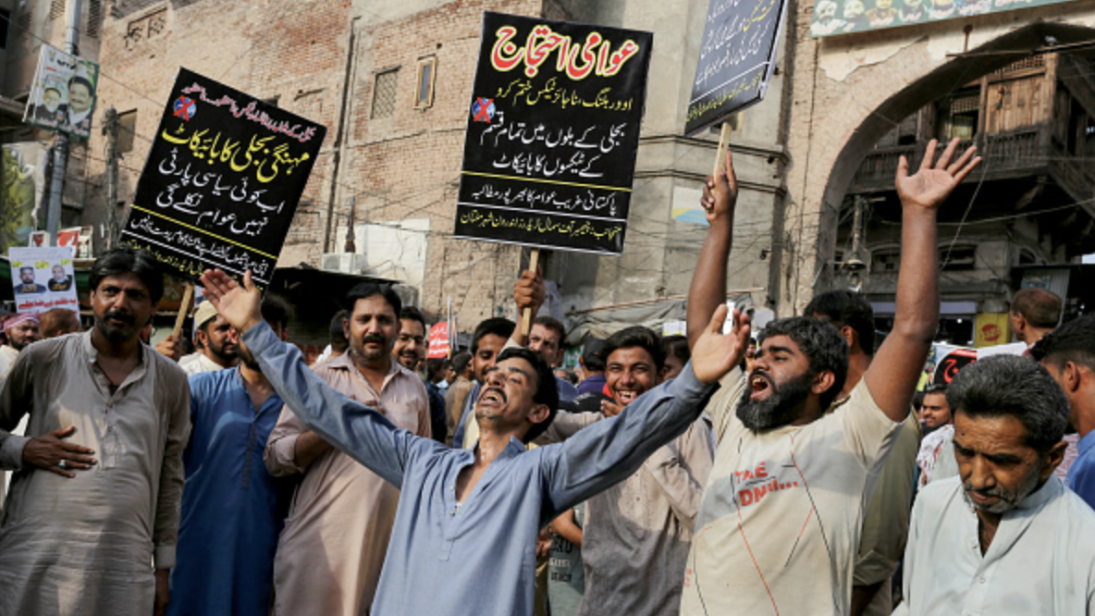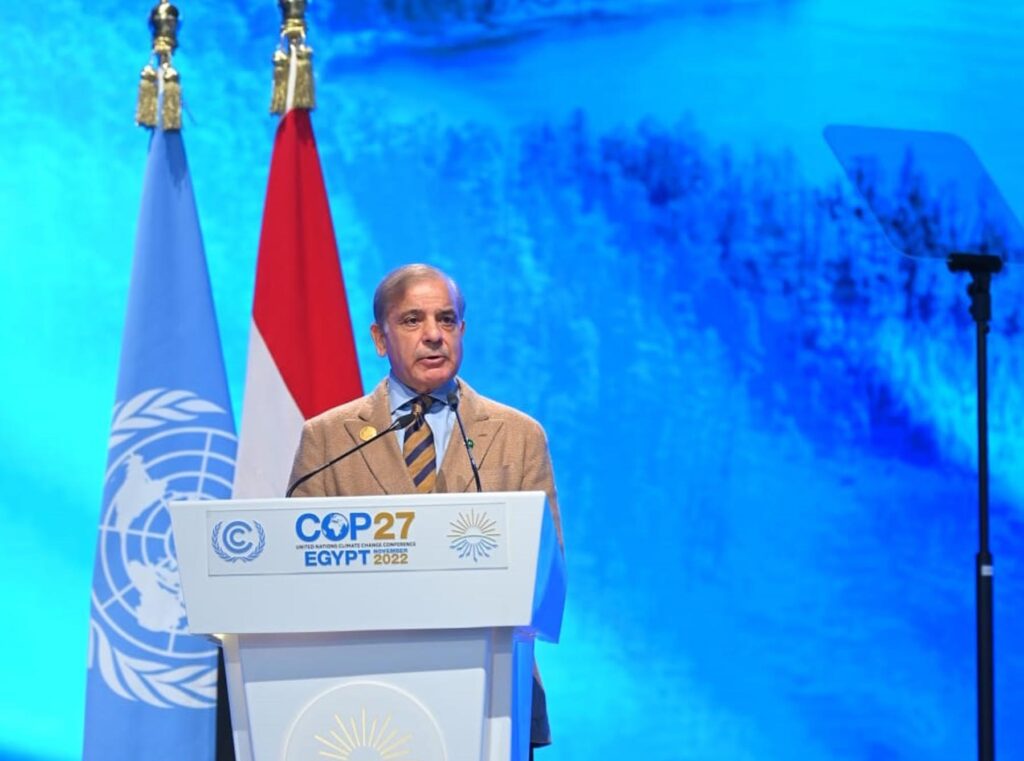
by Eman Omar
Recently, the Pakistani government severed longstanding contracts with private companies producing power, known as Independent Power Producers (IPPs), in a bid to tackle the issue of expensive electricity in the country. The IPP’s heavy dependence on burning imported fossil fuels to generate power and their history of corruption has put the country in an economic chokehold and exacerbated circular debt, which now stands at USD $9.36 billion due to poor policy planning and structural issues. Electricity distribution across the country remains uneven with some 40 million Pakistanis without access to power and 59 percent of energy coming from imported fossil fuels. Disenchantment towards the government reached a crescendo this July when some 3,000 protestors participated in a sit-in in Rawalpindi against government electricity tariffs, blocking a major highway to the capital city of Islamabad.
Corruption in Pakistan’s energy sector has put a strain on its foreign exchange reserves, led to skyrocketing domestic energy bills, and contributed to pollution while still not meeting the needs of Pakistan’s growing population. Further, it has also led to a broader conversation on phasing out fossil fuels to tap into Pakistan’s renewable energy potential.
With the 29th edition of the Conference of Parties (COP) to the United Nations Framework Convention on Climate Change on the horizon, Pakistan must take bolder steps to make this energy transition a reality. It must combine actionable domestic reform with strategic use of, instead of reliance on, international funding mechanisms to diversify its energy mix – a process that has been previously hindered by privatization and corruption within the energy sector.
Inefficiencies in the Energy Sector
In the 1990s, the Pakistani government pushed to privatize the country’s energy sector, attracting IPPs and encouraging them to invest in oil and gas-fired power plants. Today, IPPs still benefit from high subsidies that lead to significant inefficiencies in the sector, and according to a report by the World Bank, Pakistan has the highest subsidies for energy products in South Asia. In FY 2020, energy subsidies comprised about 2.6 percent of the country’s GDP. According to the Asian Development Bank, circular debt, or public debt from unpaid government subsidies, has more than quadrupled in Pakistan during the past ten years. Moreover, the government adopted “take-or-pay” purchase power agreements (PPA) with the IPPs, meaning that it was obligated to pay these private companies irrespective of how much power they were producing. For long, IPPs have purposefully misinterpreted these PPAs and over-invoiced the government.
Pakistan […] must combine actionable domestic reform with strategic use of, instead of reliance on, international funding mechanisms to diversify its energy mix – a process that has been previously hindered by privatization and corruption within the energy sector.
On October 10, due to a USD $7 billion loan from the IMF to pull Pakistan out of its energy crisis, the government terminated contracts with five of its oldest IPPs to save USD $1.48 billion over the next few years. Moreover, Pakistan is renegotiating contracts with 18 other IPPs to convert PPA from the inefficient “take or pay” to a “take and pay” model, ensuring that the government will only pay the IPPs for the energy produced and transferred to the grid. It is also important to note that by renegotiating contracts with the IPPs, the Pakistani government is revoking its sovereign guarantees, i.e. the government will not take responsibility if an IPP defaults.
While recent policy actions by the government to address long-standing corrupt practices on the part of the IPPs are a helpful start, they may take a while to bear fruit. Even so, there are several other hurdles in making Pakistan’s clean energy transition a reality.
Independent Power Producers and the Energy Transition
In 2021, Pakistan pledged to reduce its greenhouse gas emissions by an ambitious 30 percent as part of its Nationally Determined Contributions. However, at that time, experts cited how the influence and corruption of the IPPs as well as subsidies and tariffs on renewable energy sources stood before these targets. For instance, the government did not push IPPs to harness UN Carbon Credit Facilities from the UNFCCC to retrofit their thermal plants, which would have increased efficiency and reduced fuel consumption. However, Pakistan’s recent moves indicate a renewed commitment to root out the corruption in its energy sector. Ahead of the upcoming COP, this signals that the Pakistani government is ready to make good on its promises to revolutionize the domestic energy industry, including by expanding its focus on renewables.
Pakistan has excellent renewable energy potential, with the main barriers being financial. On the coastal belts of Sindh and Balochistan alone, government projections show that there is a potential to produce 50,000 MW, compared to the current 1845 MW being produced in 36 private wind farms. Additionally, Pakistan currently has seven solar projects totaling 530 MW, whereas there is a potential of 40,000 MW. Energy experts and economists in Pakistan suggest that financial obstacles stymie renewable projects, such as the high cost of initial investment in solar energy, high tariffs on construction and procurement of solar panels, and delays in government approval.
Unlocking Investment in Pakistan’s Energy Sector
In the past, Pakistan has asserted it would use up to USD $40 billion in international grants in order to accomplish its emission reductions and realize its renewable energy goals. However, as COP29 approaches and conversations on international funding occur, the Pakistani government must recognize that much international financing for such initiatives has never been successfully realized. This November, Pakistan must consider advocating for alternative forms of investment on the world stage.

Although Azerbaijan, the host of COP29, announced a new climate fund worth USD $1 billion with the support of 10 major fossil fuel-rich nations and companies to help developing countries achieve their sustainable goals, there is little chance of it becoming a reality, given the failures of previous funds. The Green Climate Fund, for example, was founded in 2010 and was supposed to have a portfolio of USD $16 billion. However, in October 2023 in Bonn, wealthy industrialized nations failed to show up with the promised funds. Similarly, the Loss and Damage Fund, which was agreed upon at COP27 in 2022, pledged USD $661 million in financial assistance to developing nations to tackle their unique climate change challenges. To date, the funds from the Loss and Damage Fund have not been distributed, and it remains unclear when they will be announced.
While international pressure and multilateralism have effectively raised awareness about the dangers of using fossil fuels and created various funds to address climate change concerns in the Global South, the failure to operationalize these funds makes multilateralism a bleak prospect for solving these problems.
Pakistan is already experimenting with potential unilateral solutions, some of which it can showcase and get support for at COP29. For instance, to aid in Pakistan’s renewable energy transition, the government founded the revival of SAARC at the UN General Assembly this September. Pakistan could collaborate with the other SAARC members by supporting an alternative climate financing structure that connects potential investment from the private sector to renewable energy projects backed by SAARC’s members, rather than relying on funding from individual countries.
As Pakistan looks to catalyze its energy transition by attracting private investors and eliminating corruption and inefficiencies in its energy sector, it should also look towards potential cross-border partnerships.
Looking towards November, COP29 can serve as a great opportunity for Pakistan to collaborate with other Global South members in both highlighting the climate change issues they face due to the high dependence on fossil fuels as well as inviting meaningful support and collective action.
source : southasianvoices
